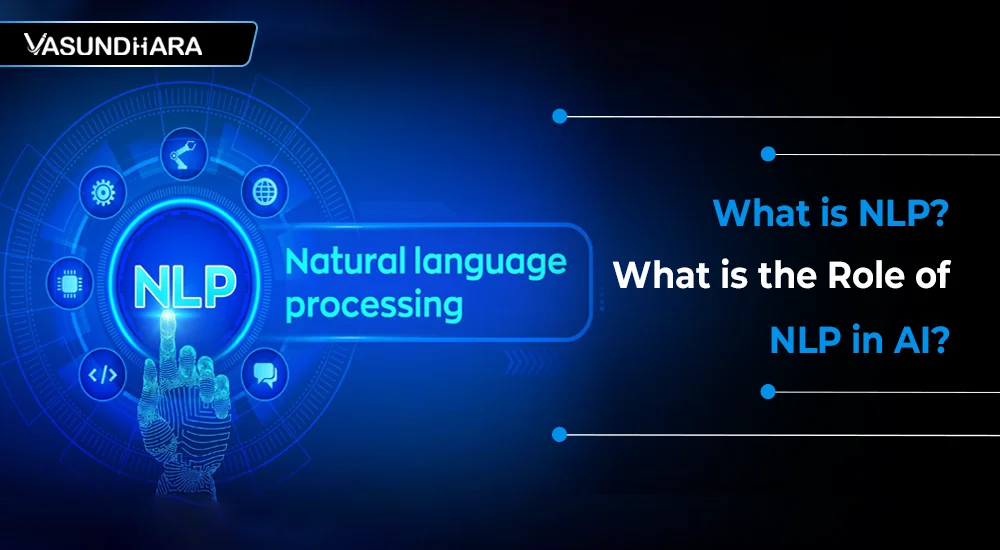What is NLP? What is the Role of NLP in AI?


- Oct 26, 2024
Natural Language Processing (NLP) has emerged as a pivotal field within artificial intelligence (AI), enabling machines to understand, interpret, and respond to human language in a way that is both meaningful and useful. As our reliance on technology grows, the need for seamless human-computer interaction becomes more critical.
This blog will delve into the fundamentals of NLP, its applications, and its integral role in the broader context of AI.
Natural Language Processing, commonly referred to as NLP, is a subfield of artificial intelligence (AI) focused on the interaction between computers and humans through natural language. The ultimate objective of NLP is to read, decipher, understand, and make sense of human language in a valuable way.
NLP encompasses various techniques that allow computers to process and analyze large amounts of natural language data. By leveraging algorithms, machine learning, and linguistic rules, NLP systems can interpret the meaning behind words and phrases, enabling a variety of applications that enhance human-computer interaction.
The origins of NLP can be traced back to the 1950s, when the first attempts were made to create machines that could understand human language. Early efforts included symbolic approaches, such as machine translation, where simple rules were employed to translate text from one language to another. However, these initial attempts often fell short due to the complexity and ambiguity of human language.
Over the decades, advancements in computer science, linguistics, and statistics paved the way for more sophisticated NLP techniques. The rise of machine learning in the 1990s marked a significant turning point, enabling NLP systems to learn from data and improve their performance over time.
Today, with the advent of deep learning and neural networks, NLP development has made remarkable strides, enabling machines to understand context, sentiment, and nuances in human language.
Also read: The Role of AI and ML in DevOps Transformation
NLP consists of several key components that work together to facilitate the understanding and generation of human language:
This involves the structure of sentences and how words are arranged to create meaning. Parsing sentences to identify grammatical components is a crucial part of this.
This component focuses on the meaning of words and phrases. It involves understanding word meanings, context, and how they interact in sentences.
This deals with the context in which language is used. Understanding the intention behind words and phrases is essential for accurate communication.
This refers to the analysis of larger pieces of text or conversation. It involves understanding how sentences relate to each other within a larger context.
This aspect focuses on the internal structure of words, including prefixes, suffixes, and root forms.
By integrating these components, NLP systems can effectively process and generate human language.
Also read: What is Generative AI? Everything You Need to Know
NLP plays a crucial role in the broader landscape of artificial intelligence by enabling machines to interact with humans in a more intuitive and natural manner.
Here are some key aspects of NLP's role in AI:
NLP enhances machine learning by providing the tools needed to convert unstructured text data into structured information. This process is vital for training machine learning models.
By employing NLP techniques such as tokenization and sentiment analysis, organizations can extract meaningful insights from vast amounts of text data, which can then be used to train AI systems.
For instance, sentiment analysis allows businesses to gauge customer opinions from social media, reviews, and surveys. This information can help improve products, services, and customer satisfaction.
One of the primary goals of NLP is to bridge the gap between human communication and machine understanding. With NLP, machines can interpret user queries, respond to commands, and provide relevant information in a conversational manner.
Virtual assistants like Siri, Alexa, and Google Assistant exemplify this application of NLP. These systems leverage NLP to understand spoken language, process user requests, and provide appropriate responses, making technology more accessible and user-friendly.
NLP plays a significant role in data interpretation by allowing organizations to analyze large volumes of textual data. From extracting insights from customer feedback to identifying trends in social media conversations, NLP enables businesses to make informed decisions based on real-time data.
NLP techniques can automatically summarize texts, categorize documents, and identify relevant information, significantly enhancing data analysis capabilities. This is particularly valuable in fields such as marketing, healthcare, and finance, where timely insights can lead to competitive advantages.
Also read: How To Build An AI Software: A Comprehensive Guide
The applications of NLP in AI are vast and varied, spanning numerous industries. Here are some notable examples:
NLP is extensively used in customer service to improve user experience. Chatbots and virtual assistants powered by NLP development can handle common queries, provide recommendations, and escalate issues to human agents when necessary. This reduces wait times and enhances customer satisfaction.
Businesses utilize sentiment analysis to gauge public opinion about their products and services. By analyzing social media posts, reviews, and feedback, companies can gain insights into customer sentiment, enabling them to adjust their marketing strategies accordingly.
In healthcare, NLP is used to analyze patient records and clinical notes to extract relevant information for improved patient care. Applications include automated medical coding, predicting patient outcomes, and assisting in diagnostic processes.
NLP algorithms can generate human-like text, which is valuable in content creation. From drafting articles to generating reports, NLP tools can assist writers by providing suggestions and generating text based on given prompts.
NLP plays a pivotal role in machine translation, allowing users to communicate across language barriers. Businesses can expand their reach globally, and individuals can access information in multiple languages.
NLP can analyze textual data from various sources, such as emails and transaction logs, to detect patterns indicative of fraudulent behavior. By identifying unusual language or communication patterns, businesses can enhance their security measures.
Also read: How To Integrate AI Into An App
Despite the advancements in NLP, several challenges remain in achieving seamless natural language understanding:
Human language is inherently ambiguous, with words and phrases often having multiple meanings depending on context. NLP systems must be able to discern these nuances to accurately interpret user intent.
For example, the word "bark" can refer to the sound a dog makes or the outer covering of a tree. NLP systems need context to determine the correct interpretation.
Language is deeply influenced by culture, and different regions may have unique expressions, idioms, and colloquialisms. NLP systems must account for these cultural nuances to avoid misunderstandings and ensure accurate communication.
With thousands of languages and dialects worldwide, NLP systems face challenges in providing effective support across all languages. Developing models that can accurately process and understand low-resource languages remains a significant hurdle.
The future of Natural Language Processing (NLP) in AI is set to be transformative, driven by rapid advancements in deep learning and multimodal AI systems. As models like BERT and GPT continue to evolve, they will enable machines to understand and generate human language with even greater accuracy and contextual awareness.
Multimodal AI, which integrates text, images, and audio, will create more intuitive interactions, paving the way for more complex AI assistants and smarter systems.
Additionally, personalized NLP applications will enhance user experiences by tailoring responses to individual preferences. Ethical considerations, such as reducing bias and increasing transparency, will also be crucial in shaping responsible AI systems.
As NLP advances, it will become even more integral to everyday technologies, improving communication, decision-making, and automation across industries, from healthcare to customer service, revolutionizing how humans interact with machines.
Natural Language Processing is a vital component of artificial intelligence that enables machines to understand, interpret, and interact with human language. With applications ranging from virtual assistants to sentiment analysis, NLP is transforming the way we communicate with technology.
As NLP techniques continue to advance, they will enhance human-machine interaction, improve data interpretation, and provide valuable insights across various domains. However, challenges such as ambiguity, cultural nuances, and ethical considerations must be addressed to ensure the responsible development and deployment of NLP systems.
The future of NLP in AI is bright, promising exciting innovations that will redefine how we interact with technology. As we move forward, embracing these advancements will be essential for leveraging the full potential of NLP in creating a more connected and intelligent world.
If you require any services for web development, please contact us. We have a team of app development professionals ready to assist your business expand massively in every manner. Explore our diverse portfolio.
You can follow us on all social media platforms, including LinkedIn, Instagram, and Facebook, to stay up to date on the latest technologies and trends.
Copyright © 2025 Vasundhara Infotech. All Rights Reserved.
